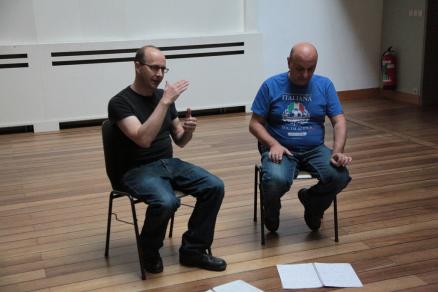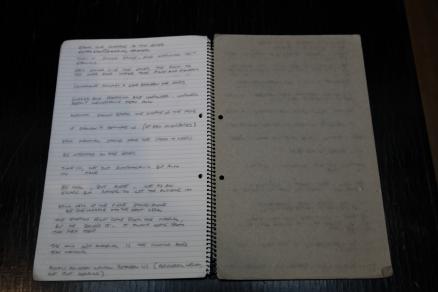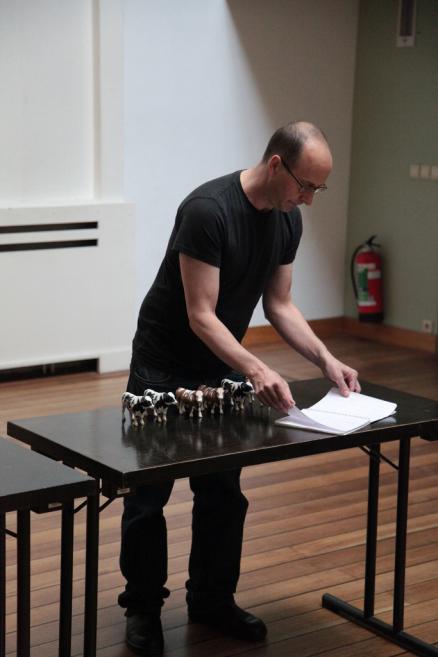Jonathan Burrows & Matteo Fargion Research Sessions
Jonathan Burrows & Matteo FargionResearch SessionsIn July 2011, Burrows and Fargion met in Brussels with Nik Haffner, an experienced dance and digital media collaborator (see Timelapses Project for one example of Haffner's research), to develop a concept for their Motion Bank digital score project. From this meeting the idea emerged to investigate the element of linear counterpoint that interests them 'where something which happened before influences what happens later, and visa versa'. As a test, they recorded 21 fragments of material from the six duets they created together since 2002. Here is a random selection of ideas noted at that meeting by Haffner: - The structure of the web-score – a counterpoint in itself. - Finding the right tone (for example hand-made and human-scale). - User going away with a sense of not having learned, but rather having experienced potentials. - The idea of 100 pages (which reveal counterpoint within their chronological order). See Haffner's original document. |
|
|
The July meeting was followed by a first meeting in October 2011 with Motion Bank digital artists Florian Jenett and Amin Weber when more counterpoint extracts and commentary were videotaped and scores & notebooks were photographed. From this a concept was developed for data recording in The Frankfurt Lab, making use of the digital video (2-D and 3-D) and audio equipment that recorded Deborah Hay’s material last year. A tech-rider prepared by Jenett in early 2012 gives insight into practical aspects of this setup. |
|
|
At the second meeting, patterns used in their work was a main discussion topic, e.g. Jonathan explained the loop of three he has “played for 14 years - it’s in every piece that I do". Another important topic to emerge were the myriad 'hidden influences' they think about and make in their work (see: Show And Tell on Youtube). Also discussed the idea of translating one thing into another (e.g. from score into the performance) and the question 'What would sitting duet look like if it were MORE complex?' |
|
|
A 3rd meeting was held in Brussels in April 2012 to prepare for the test filming (16-18 May 2012). Because data recording for digital scores makes use of the possibilities for computational analysis and digital post-processing, the recording setup had to be optimized for ‘what the computer can see’ as different from the human eye. This required unique adaptations for sound, light and spacing (e.g. Burrows and Fargion had to sit further apart than they usually do in performances). The new work One Flute Note (2012) was added to the list of duets to be recorded. Thoughout these meetings former ideas were affirmed, refined or set aside and new ideas emerged. A selection of two from Nik Haffner's notes after this 3rd meeting. - “website beat” (same speed in several pieces….. could be connected/related …) - Recognizing the patterns, but also recognizing the deviation. See Haffner's original document. |
|
Jonathan Burrows & Matteo Fargion Process Documentation Pages:
http://motionbank.org/en/content/jonathan-burrows-matteo-fargion
http://motionbank.org/en/event/jonathan-burrows-matteo-fargion-research-sessions
http://motionbank.org/en/event/jonathan-burrows-matteo-fargion-test-filming
http://motionbank.org/en/event/jonathan-burrows-matteo-fargion-guest-performances
http://motionbank.org/en/event/jonathan-burrows-matteo-fargion-final-filming
http://motionbank.org/en/event/jonathan-burrows-matteo-fargion-score-production-sessions
INFO
As a response to the COVID-19 / Corona situation we just opened our research system (including Piecemaker and MoSys) for dance education and practice.
This year Motion Bank celebrates it's 10 anniversary. As soon as it becomes possible to make final plans we will release information about these.
Please consider subscribing to our newsletter.

























